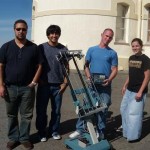
Amanda Taylor, of Emerson, Ark., who graduated with her bachelors in engineering physics at SAU this May, along with Perry Grant, a senior from Camden, Ark., and Noe Cuevas, a senior from Houston, along with their mentors Dr. Abdel G. Bachri, assistant professor in physics, and Dr. Azriel Goldschmidt, a local scientist at Berkeley Lab, spent 10 weeks preparing for and constructing two cosmic radiation detectors, which enable detection of high energy gamma rays and muon particles. To better understand radiation fluctuation with altitude, the detector was tested at different elevations with respect to sea-level, and then brought to SAU so that other students can learn about cosmic and gamma rays.
According to Bachri, scientists believe that cosmic radiation had a great impact on the evolution of life on our planet.
“DNA mutation and damage which are implicated in many cancers and genetic disease can be caused by high energetic cosmic rays; therefore making the study of these cosmic rays crucial to us. The best aspect of this summer research was that we were able to bring back the cosmic detectors to SAU,” Bachri said. “This means the experience gained by the SAU Faculty and Student Team does not end in Berkeley, other students will benefit from the units to further understand the behavior of cosmic and gamma rays.”
Although the students were understandably nervous about working among some of the most elite scientists in the world, Cuevas described the scientists as very “down to earth,” and said the students were made to feel very welcome. In fact, the lab space assigned to the team to work as well as the tools and equipment they used was that of Professor George Smoot; the Physics Nobel prize winner of 2006 for his work which helped confirm the big-bang theory of the universe using the Cosmic Background Explorer Satellite.
“Mostly what this experience helped to teach us is how scientists work and what kind of work ethic they have,” Cuevas said.
Grant, who received his associate’s degree in electronics from SAU Tech before coming to SAU to pursue a four-year degree, said he enjoyed the project because it enhanced their learning outside of the classroom.
“We were not just learning about radiation from a textbook, we were finding out firsthand how particles change and reach the earth’s surface,” Grant said.
Team members will now be able to try out other ideas they did not have time to complete while in California. The seniors, Cuevas and Grant, along with Professor Bachri, will also help teach other students about the cosmic radiation detectors and how they can be used to study physics and engineering. Bachri said the devices create possibilities for meaningful undergraduate research that will introduce students to frontline physics research.
In addition to the two devices the students were involved with building firsthand, the summer research also resulted in three papers submitted for publication in the Journal of Undergraduate Research, owned by the U.S. Department of Energy. The students also reported their findings via poster session organized by the Lawrence Berkeley National Laboratory –Center of Science and Engineering Education at the University of California, Berkeley. Another positive outcome is that Taylor, who graduated from May at SAU, received a graduate fellowship offer and is now pursuing a doctorate in applied physics at Oklahoma State University.
